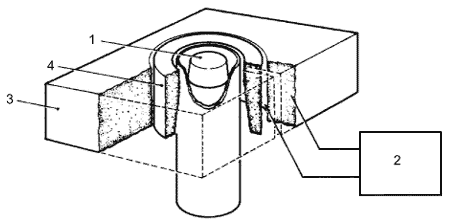Magnetic pulse welding
Description
Magnetic pulse welding is a high speed single shot welding process for joining tubular components or tube to a solid part in a lap configuration. It is similar in operation to magnetic forming. The components to be welded are positioned within a
coil, through which a heavy current flows from a capacitor discharge supply.
Eddy currents are induced in the components and the interaction of the magnetic fields so created cause forces to be developed in the coil and components (conductors with current flowing in the same direction attract one another and conductors
with current flowing in opposite directions repel). The forces developed between the components can be sufficiently high that the surfaces impact together at a slight angle to form a jetting action similar to an explosive weld. This produces a solid
phase joint with very little heating.
 |
Fig.1.
Schematic example of magnetic pulse welding
1 - Plug to tube bond (taper exaggerated)
2 - Capacitor discharge power supply
3 - Permanent water cooled coil
4 - Magnetic field shaper
|
Current status
The process was developed in the early 1970s. It has been used for welding caps into aluminium alloy tubes for nuclear application and was demonstrated for a range of automotive applications in steel with an induction preheat included, although
recorded applications were rare, possibly because of reliability difficulties at that time.
However, interest has recently increased for automotive applications in particular and equipment suppliers are conducting application studies.
Important Issues
As the process has little published history, there needs to be an understanding of the capabilities of the process and the properties of joints produced. Aspects such as joint design guidelines, process tolerance and quality control need to be
established.
Benefits
The technique appears to be capable of joining a range of materials, including dissimilar combinations. The welding speed is very high as the complete weld is made in milliseconds. The power demand is low and the process is claimed to have excellent
reproducibility. In principle, the process is attractive for a range of mass production tubular applications, provided the joint designs allow the welding mechanism to operate effectively without damage to the part.
Risks
Welding performance needs to be established for particular applications but there are few safety issues as the equipment can be fully automated.
|
